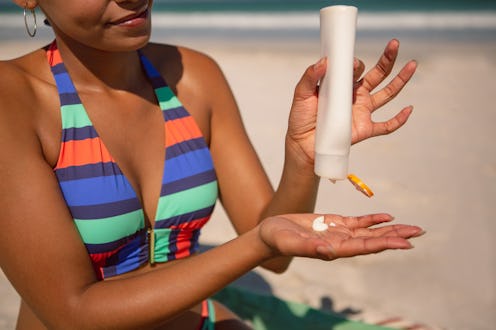Life
High SPF Sunscreens Aren't Always Worth Your While For This Unexpected Reason

Despite a lot of chatter around sun protection, there are still a few sunscreen myths that need clearing up. One of them relates to whether a high SPF sunscreen is better than a low one. This particular question has come to the forefront once again thanks to a few comments from Nicole Kidman.
In a recent interview with The Cut, the actress said that she wears SPF 100+; a factor that is rarely seen in the UK. "I reapply all the time," she noted. "I was just shooting outside last week. It was almost 100 degrees [around 38°C] in NYC. I was out in the sun all day from beginning to end. I reapplied SPF 100+, which is crazy, but I didn’t get burnt once.”
The SPF number is designed to indicate how long the sunscreen will allow you to stay in the sun before your skin begins to burn. With SPF 15, for example, it would take 15 times longer to burn than with no sunscreen at all, reports the BBC.
It's therefore easy to assume that the higher the SPF, the more protected you are. But according to experts, this isn't strictly true because the difference between higher SPFs is minimal. "SPF 30 filters out 97 percent of UVB radiation, and SPF 50 filters out 98 percent of UVB radiation — an increase of only 1 percent," says Ian Taylor, cosmetic scientist for beauty brand Green People.
In fact, he adds, the 2006 EU recommendations on sunscreen state that "sun lotions offering protection in excess of SPF 60 should be labelled SPF 50+, and that no claims for higher protection than this should be made." The document also notes that "sun protection factors above 50 do not substantially increase the protection from UV radiation."
There is another issue. "The problem with products offering very high SPF levels is that although they will give excellent protection against UVB radiation, it is unlikely that they will offer the same high levels of protection against UVA radiation," Green People note on their website.
Ultimately, you may not experience sunburn with a high SPF, but your skin could still be damaged in the long term, leading to premature ageing. (Broad spectrum sunscreens protect against both UVA and UVB rays, so look out for this on the label.)
So should you ever buy something labelled SPF 100? As The Times reports, an SPF 100 does block "99 percent of UVB rays," giving a small amount of extra protection. And a 2018 study published in the American Academy of Dermatology concluded that SPF 100+ sunscreen was "significantly more effective in protecting against sunburn than SPF 50+ sunscreen in actual use conditions."
Some experts, however, worry that people's behaviour alters when using a super high SPF. As dermatologist Steven Wang wrote for the Skin Cancer Foundation, people often stay out in the sun for a longer period and don't reapply sunscreen, potentially leading to more skin damage.
What is equally, if not more, important than an SPF figure, says Holly Barber from the British Association of Dermatologists (BAD), is the proper application of sunscreen. "If someone buys a very high SPF sunscreen but falls into the common trap of applying it too thinly, or not reapplying it regularly enough, or missing patches, then the skin will still be damaged by the sun," she states, adding that the BAD recommends an "SPF 30 sunscreen with a minimum four-star UVA rating."
At least six teaspoons' worth of product is needed to cover the body of an average adult and to get the full benefit of the SPF you're using, writes the organisation. It's also advisable to apply sunscreen 30 minutes before stepping outside and then once again as soon as you're outdoors. Reapply every two hours or straight after swimming, sweating, or drying yourself with a towel.
Remember that no sunscreen can provide you with 100 percent protection from the sun. Combining it with time spent in the shade and adequate protective clothing is the best strategy, the BAD's Instagram advises.
This article was originally published on